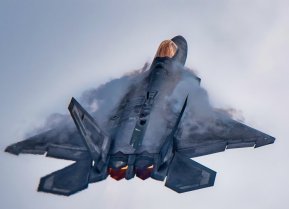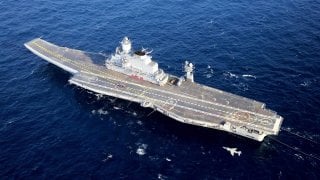India's Navy Has Arrived
True to its tradition of nonalignment, India has declined to join the U.S.-led effort to keep open shipping lanes in the Red Sea, where Houthi rebels have pummeled merchant traffic indiscriminately with drones and antiship missiles. At the same time, though, New Delhi has dispatched ships of war to the Arabian Sea and Gulf of Aden to protect Indian-flagged merchantmen while succoring ships of any flag that suffer damage from Houthi strikes. Ten Indian Navy warships now patrol waters to the subcontinent’s west.
Go Indian Navy!
True to its tradition of nonalignment, India has declined to join the U.S.-led effort to keep open shipping lanes in the Red Sea, where Houthi rebels have pummeled merchant traffic indiscriminately with drones and antiship missiles. At the same time, though, New Delhi has dispatched ships of war to the Arabian Sea and Gulf of Aden to protect Indian-flagged merchantmen while succoring ships of any flag that suffer damage from Houthi strikes. Ten Indian Navy warships now patrol waters to the subcontinent’s west.
This is as it should be. Freedom of the sea is a common trust of all seafaring nations. All trading nations should safeguard it lest the briny main degenerate into anarchy, with all the mercantile and thus economic havoc nautical lawlessness would wreak. It’s fitting for India to act as a steward of maritime security in the Indian Ocean, where it regards itself, not implausibly, as a beneficent hegemon.
There are many strands to India’s image of itself, but an important one derives not from this civilization-state’s venerable history but from nineteenth- and early twentieth-century U.S. diplomatic history. In 1961 founding prime minister Jawaharlal Nehru went before parliament to make the case for expelling Portugal from its coastal enclave of Goa, a remnant of the Portuguese Empire ensconced on the subcontinent since the sixteenth century. Nehru appealed not to India’s grand past or to some Indian thinker of renown like the ancient philosopher Kautilya.
He grounded his appeal in the Monroe Doctrine (1823).
And he took President James Monroe’s logic to lengths that would have baffled Monroe, fashioning an Indian Monroe Doctrine to govern New Delhi’s conduct of diplomacy and military affairs following independence from the British Empire. Monroe merely forbade European empires to wrest back American colonies lost during a spate of revolutions. Contrary to the popular view, he did not vow to drive Europeans from the Western Hemisphere altogether. This was not a crusading doctrine. He just wanted to freeze a status quo convivial to the United States as well as newly independent Latin American republics.
Hands off, Europe.
Nehru went much further than Monroe, declaring not just that India must evict Portugal from the subcontinent but that “any attempt by a foreign power to interfere in any way with India is a thing which India cannot tolerate, and which, subject to her strength, she will oppose. That is the broad doctrine I lay down” (my emphasis).
Powerful words, but apt. When laying down rules of conduct, practitioners of statecraft tend to phrase them in broad and somewhat vague terms, so as not to bind themselves or their successors to some specific course of action that might run counter to national interests or purposes of the day. Thus liberated, they can interpret and reinterpret a doctrine to fit circumstances and national needs. Nehru set an enduring pattern for Indian foreign policy.
How will current and future leaders apply Nehru’s broad doctrine? Look back to look ahead. To gaze through a glass darkly into India’s future, we can look to America’s past. The Monroe Doctrine underwent at least three phases as domestic and geopolitical circumstances metamorphosed around the United States. From the 1820s through the 1890s the republic freerode on maritime security supplied by the former foe, Great Britain and its Royal Navy. Britain saw an interest of its own in keeping rival empires from returning to the Western Hemisphere, and it had a fleet capable of barring access. Interests converged to U.S. benefit.
British endeavors created a safe space for the United States to fight out its North-South enmities, undergo an industrial revolution, and spread to the Pacific coast, all without the trouble and expense of maintaining a large standing military.
Freeriding on U.S.-supplied maritime security represents one potential future for India’s Monroe Doctrine, and indeed New Delhi arguably hewed to a freerider policy in the Indian Ocean for decades after Nehru enunciated his doctrine. That softly, softly approach remained in place until recent years, when an aggressive outside power, China, started encroaching in the Indian Ocean and U.S. naval supremacy seemingly tipped over into decline. India needed independent options.
Freeriding on an uncertain benefactor appears less and less tenable in Indian eyes.
Back to the Americas. By the 1890s the United States’ national project was largely complete, and the republic had begun to take its station as a regional sea power of note. The U.S. Navy was riveting together its first steam-propelled, armored, big-gun battle fleet. Naval might gave U.S. statesmen options beyond dependency on the Royal Navy, whose supremacy was coming under strain with the rise of imperial Germany, a challenger entertaining its own seaward ambitions.
In 1895, in fact, the Grover Cleveland administration injected itself into a dispute between Britain, then the ruler of colonial Guyana, and neighboring Venezuela. It appeared the two contenders might go to war over control of resource-rich territory along their mutual frontier, and that Britain might well seize land from Venezuela—breaching the Monroe Doctrine’s proscription against European territorial expansion in the Americas.
So lordly was Washington’s conduct during the Venezuelan border quarrel that Richard Olney, Cleveland’s secretary of state, proclaimed that the United States was “practically sovereign” throughout the hemisphere. This was a statement of breathtaking scope. After all, a sovereign power wields a monopoly of force within lines on the map called borders. In Olney’s view the republic was entitled to get its way in any controversy that engaged its interests, and it now had the naval power to outmuscle any extraregional power bold enough to defy its will. London acquiesced in Washington’s demand to act as mediator in the dispute, and in effect the United States anointed itself the regional strongman of the Americas.
Similarly, India could strive to make itself a strongman as American sea power wanes, China makes military inroads in the Indian Ocean region, and the Indian economy furnishes the wherewithal to fund a great navy. Depending on how you count, the Indian Navy already comprises around 140 hulls, including a pair of operational aircraft carriers, and that number is only set to grow in the coming years. Like Cleveland’s America, India increasingly boasts the armed strength to assert itself in regional diplomacy.
Like fin de siècle America, it could take to throwing its weight around.
In 1904 the Monroe Doctrine passed into a third phase under the tutelage of President Theodore Roosevelt. Roosevelt actually toned down the doctrine, distancing himself from Olney and Cleveland’s bombast. In his 1904 message to Congress, TR claimed an “international police power” meant to keep Latin American territory from falling into the hands of European navies that might construct naval bases there in order to harry or even interdict sea routes leading to and from the Panama Canal, once that waterway entered service.
Forcible international debt collection precipitated Roosevelt’s 1904 “corollary” to the Monroe Doctrine. Unstable Caribbean governments had a habit of defaulting on their debts to European banks. When that happened, common practice was for the European government affected by nonpayment to send the navy to seize the customs house in the defaulting country and use the proceeds from oversea trade to repay the bankers.
TR didn’t object to compelling sovereign states to repay debts they had freely undertaken, but he fretted over the potential for an infraction of the Monroe Doctrine. To prevent a malign chain of events he announced that the United States would intervene in disputes in which it appeared Europeans might take Latin American ground. He mediated a debt dispute embroiling Santo Domingo—and set a precedent for the United States to play a constabulary role under the aegis of the Monroe Doctrine.
Like Roosevelt, Indian leaders could adopt a self-restrained policy meant to forestall outsiders’ geopolitical gains in the Indian Ocean, preserving India’s autonomy, and to uphold seagoing societies’ liberty to use the sea for commercial, diplomatic, and military pursuits. New Delhi could make India the constable of the Indian Ocean.
And indeed, protecting shipping from assault—as the Indian Navy is doing—is quintessential constabulary work.
So there you have three potential futures for Indian diplomacy, extrapolating from early U.S. history: freerider, strongman, and constable. Which will it be? Or will India depart from the American model—and chart some novel course of its own?
About the Author: Dr. James Holmes
Dr. James Holmes is J. C. Wylie Chair of Maritime Strategy at the Naval War College, a Nonresident Fellow at the University of Georgia School of Public and International Affairs, and coauthor of Indian Naval Strategy in the 21st Century. The views voiced here are his alone.


